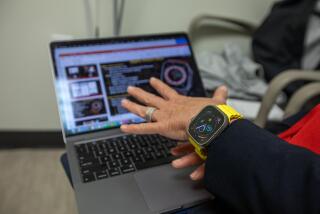Palm-Size Wireless Computer Conveys Vital Signs to Doctors on the Go : Technology: Hewlett-Packard’s new device helps faraway physicians tend to hospitalized patients.
NEW YORK — Good news for doctors on the golf course, and their patients in the hospital: Hewlett-Packard Co. has introduced a palm-size wireless computer that receives such vital signs as electrocardiograms, heart rates and blood pressure over the airwaves.
Hospitals grappling with an emergency can send the data anyplace within the range of a pager. So a doctor on the 14th hole can check out a patient and call in a diagnosis over a cellular phone.
Although the system, called PalmVue, will cost hospitals $25,000 each, executives of the computer company billed it as a money-saver during a presentation to industry analysts Tuesday.
“When you can provide treatment sooner and more accurately, the patient progresses faster and can be released from the hospital sooner, which reduces cost,” said Mike Bunnell, a marketing manager with Hewlett’s medical products group in Andover, Mass. That should be especially attractive to hospitals under pressure from health maintenance organizations to cut their costs, the company said.
Most hospitals already have electronic monitoring systems that feed into a central computer, where a nurse can see the vital signs of many patients.
The PalmVue system sends this data into a Hewlett-Packard computer with a telephone modem. The modem transmits the data over the hospital’s paging system.
The PalmVue unit is simply a standard Hewlett-Packard miniature computer with a pager and extra software. When paged, the doctor pushes a couple of buttons to display the data, along with any notes the nurse sends. Hewlett will offer five PalmVues with each system, with additional units costing $2,000 each.
Of course, many doctors are already getting data on the road through regular pagers and fax machines.
PalmVue has the unique ability to transmit electronic wave forms--just like those at the hospital bedside--for up to 15 seconds, the company said.
That ability was critical recently for a patient of Dr. Patricia McIlvaine of Wing Memorial Hospital in Palmer, Mass., who was among those who tested the PalmVue.
McIlvaine said she was able to eyeball the electronic heart pulses of a hospitalized patient from her car a few months ago. She determined that he had a life-threatening unstable heartbeat and needed to be given an electric shock to get his heart back to its proper rhythm. She phoned in her diagnosis and rushed to the hospital.
“They had everything set up so I could walk through the door . . . zap him and get him out of trouble. It saved me about 20 minutes and he wasn’t going to be around living with that heart rhythm for too much longer.”
The only problems McIlvaine anticipated for the PalmVue concern the paging systems, which may have to be upgraded to avoid radio interference.
Cognizant of this, Hewlett added electronics to the PalmVue that block an inaccurate wave from displaying on the screen. The doctor simply gets a message to phone the hospital, said Dr. David Albert, chairman of Data Critical Corp., a wireless data transmission company that helped develop the PalmVue. In tests prior to Food and Drug Administration approval, the PalmVue had a success rate of 90%, he said.
Although the medical data is sent over the air, confidentiality is protected because it is scrambled, Albert said.
Despite their enthusiasm, the executives said Tuesday they are unsure just how many doctors might make use of the device.
For one thing, it works only with hospital monitoring equipment manufactured by Hewlett--usually an investment of several hundred thousand dollars.
While Hewlett is the leading seller of such equipment in the United States, analysts said it is unlikely hospitals would replace their monitors just to get the PalmVue.
Still, most hospitals must buy new monitors every five to 10 years just to keep up with technology, so McIlvaine said that gives Hewlett an opening.
But McIlvaine doubted large teaching hospitals would be interested in the system because many have enough doctors on duty around the clock.
“I think it’s a really cool idea for medium and small hospitals where staffing may be thin and they’re the only show in town,” she said.
Industry analysts were generally impressed. For doctors who admit many patients to a single hospital intensive care unit, it “will be a basic tool, readily accepted, and will have tremendous effects on the practice of medicine,” said Gene Gargiulo, managing director of Brookehill Equities Inc., a New York securities firm.
More to Read
Inside the business of entertainment
The Wide Shot brings you news, analysis and insights on everything from streaming wars to production — and what it all means for the future.
You may occasionally receive promotional content from the Los Angeles Times.








